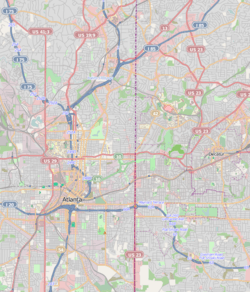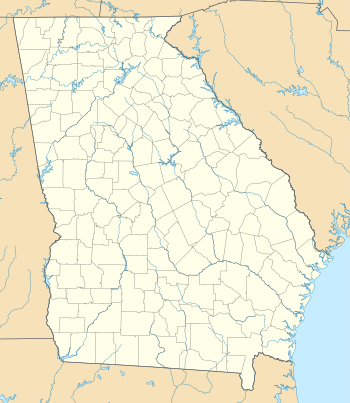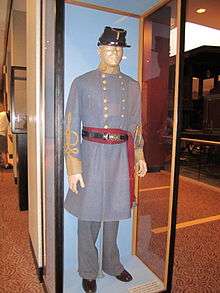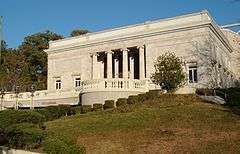Atlanta Cyclorama & Civil War Museum
|
Cyclorama of the Battle of Atlanta | |
|
Atlanta Cyclorama building | |
   | |
| Location | Atlanta, Georgia |
|---|---|
| Coordinates | 33°44′2.97″N 84°22′15.83″W / 33.7341583°N 84.3710639°WCoordinates: 33°44′2.97″N 84°22′15.83″W / 33.7341583°N 84.3710639°W |
| Built | 1885 |
| Architect | American Cyclorama Co.; John Francis Downing |
| Visitation | 54,489 (2014)[1] |
| NRHP Reference # | 71000274[2] |
| Added to NRHP | December 9, 1971 |
The Atlanta Cyclorama and Civil War Museum was a civil war museum located in Atlanta, Georgia, its most noted attraction being the Atlanta Cyclorama, a cylindrical panoramic painting of the Civil War Battle of Atlanta. It is currently closed to the public. The Atlanta History Center is in the process of restoring The Battle of Atlanta painting and relocating it to its Buckhead property. The restoration process began in 2015. The plan is to open the building in 2017 to allow the public to view the ongoing restoration of The Battle of Atlanta painting, with a full opening and dedication following in 2018. Once the painting has been fully restored, Atlanta residents, tourists, and other visitors can see The Battle of Atlanta as it was originally intended to be viewed when it was painted in 1886, a hyperbolic or hourglass shape.
Atlanta Cyclorama
Visitors viewed the cylindrical painting from the inside, entering through an entrance in the floor. After being seated, the central cylinder rotates slowly, affording a view of the entire painting. The painting at one time was the largest oil painting in the world, and if unrolled would measure 42 feet (13 m) high by 358 feet (109 m) long. It held this record until 2004, when it was surpassed in size by a mural at the Kalamazoo Air Zoo measuring 32 feet (9.8 m) high by 800 feet (240 m) long.[3]
The Cyclorama was narrated at one time by volunteers, some of whom were veterans or widows of veterans of the Civil War. In 1960, Atlanta Mayor William B. Hartsfield accepted the donation of a recorded narration written by Junius Andrew Park, Jr., in honor of his father, Junius Andrew Park, Sr., who was born and raised in Atlanta. Research was done by Lurline Richardson Park, the writer's wife. The narration was musically scored by Atlanta musician Sam T. Wilhoit, and the narration was read by Hollywood actor Victor Jory, who appeared in the original motion picture Gone with the Wind. All parties donated their time and labor. In later years, a revised narration was produced and narrated by actor Shepperd Strudwick.
Civil War museum

The museum displayed pictures and artifacts from the Civil War, including the Texas, a steam locomotive that pursued the captured train the General in the Great Locomotive Chase during the war. This raid was depicted in the 1927 Buster Keaton film The General and the 1956 Disney film The Great Locomotive Chase.
A movie theater inside the museum showed a short film about the Atlanta Campaign, narrated by James Earl Jones, to visitors before they view the painting. The cyclorama painting itself is augmented by a three-dimensional diorama in front of the painting and a narration of the events of the battle and the history of the painting. A popular story concerning the diorama involves actor Clark Gable. During the celebrations surrounding the opening of the film Gone with the Wind, the film's actors visited the Atlanta Cyclorama. Gable allegedly claimed that the only way the painting could be any more magnificent was if he were in it, prompting the management to add Gable's features to one of the sculptures in the diorama, that of a dying soldier.
Future plans
In July 2014, Atlanta city officials announced plans to relocate the Cyclorama to the Atlanta History Center in Buckhead.[1] The possibility of a move started soon after the 2008 restoration of the only other panoramic painting in the United States, the Gettysburg Cyclorama.[1] In 2011, a panel of city leaders and historians was appointed to investigate options for restoring and possibly relocating the painting, which was estimated to cost at least $8 million to restore.[1] Three options were considered: relocate to Centennial Olympic Park area, near the Georgia Aquarium and other new tourist attractions; relocate to Atlanta History Center; or, remain in current location.[1] The Atlanta History Center was selected after a local couple offered $10 million towards the project, with the History Center noting in its announcement that it had already raised $32.2 million for the move.[1]
The Cyclorama's final day open to the public was June 30, 2015, after which it closed in preparation for the move. The History Center began construction in fall 2015 on a new 23,000-square-foot (2,100 m2) building to house the painting, the diorama and the Texas locomotive.[1] During the construction, restoration work will begin on the painting, including the addition of areas of the painting that were removed prior to its installation in the current Grant Park facility.[1] After the History Center building is completed, the painting and diorama will be moved to the new facility where restoration will continue, at times in view of History Center visitors.[1] The Grant Park building will be given to Zoo Atlanta, where it will be used as office and event space, including a new private viewing area for a proposed expansion of the zoo's African elephant habitat.[1]
See also
References
- 1 2 3 4 5 6 7 8 9 10 Howard Pousner (2014-07-23). "Cyclorama to make big move to Atlanta History Center". ajc.com. Cox Newspapers. Retrieved 2014-08-04.
- ↑ National Park Service (2007-01-23). "National Register Information System". National Register of Historic Places. National Park Service.
- ↑ Davis, Stephen (2004-04-27). "Cyclorama". New Georgia Encyclopedia. Retrieved 2009-08-30.
External links
- Official website
- New Georgia Encyclopedia
- Then / now photographs of the Cyclorama building, taken in 1953 and 2005
- Website of the International Panorama Council IPC listing all existing panoramas and cycloramas worldwide
